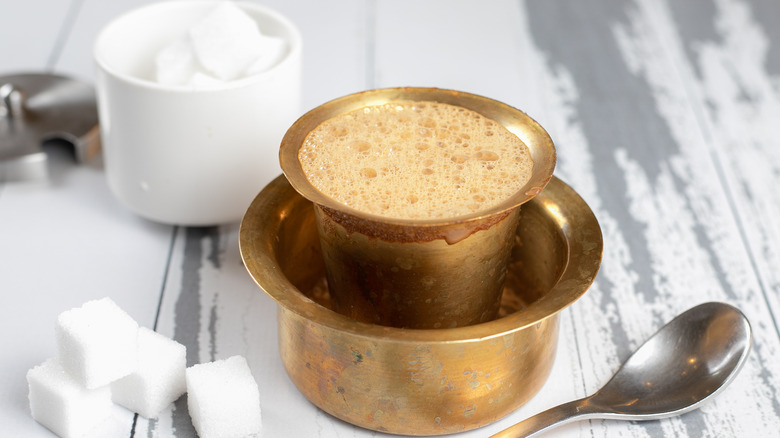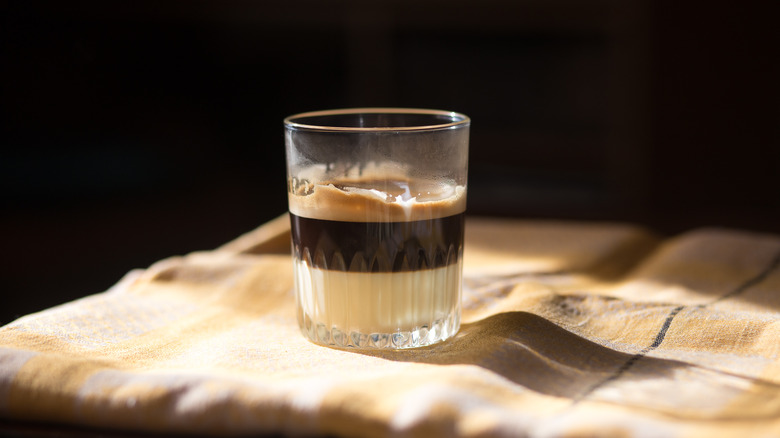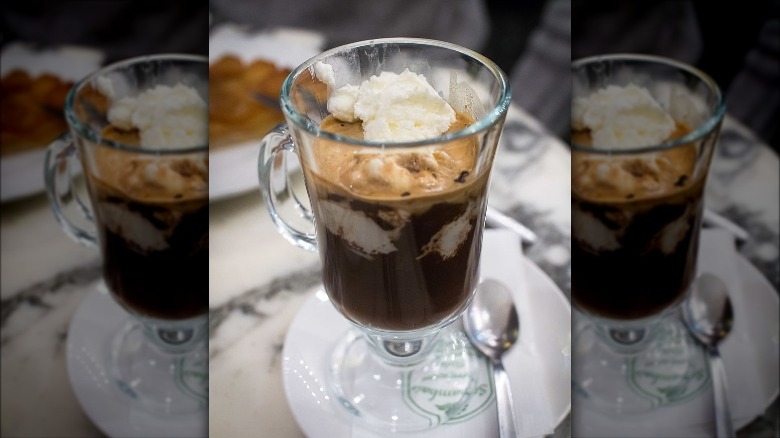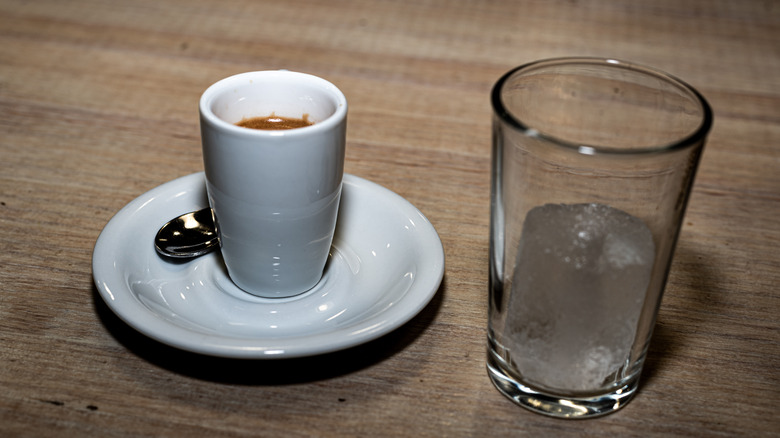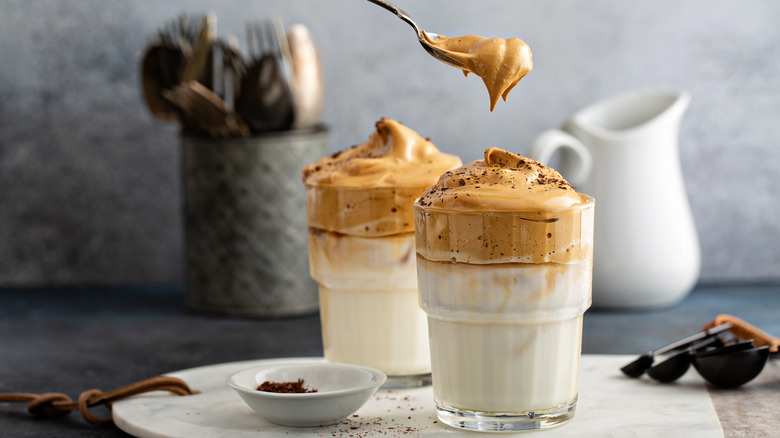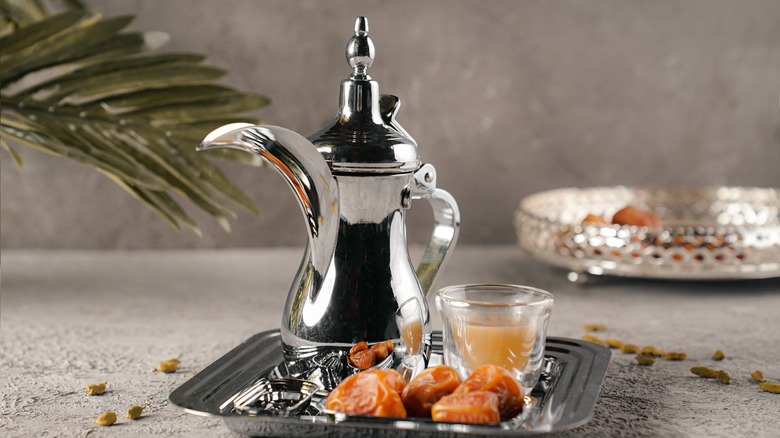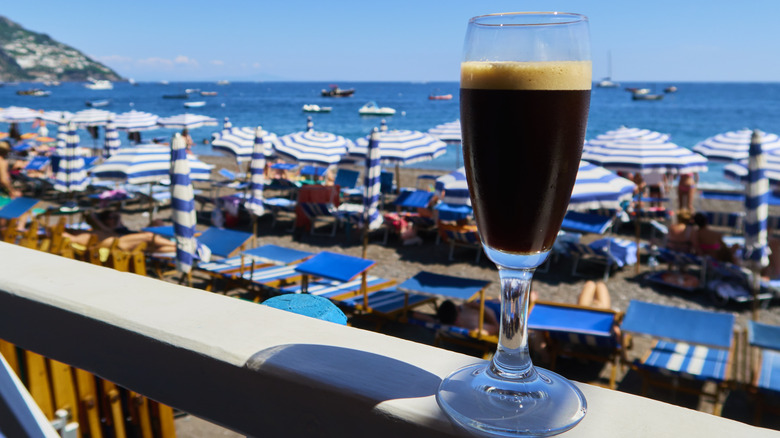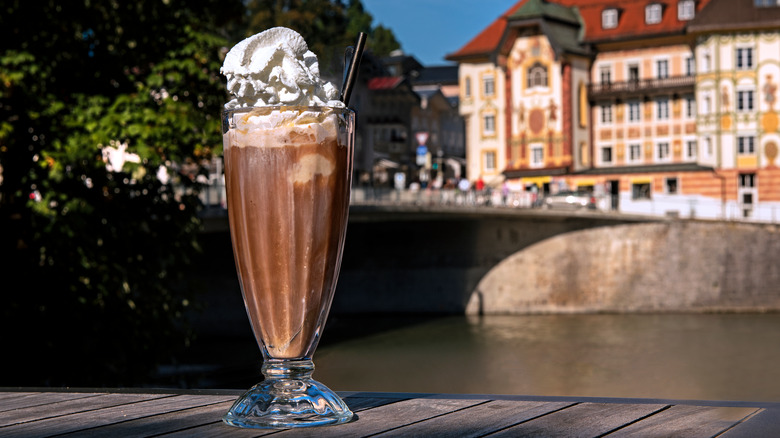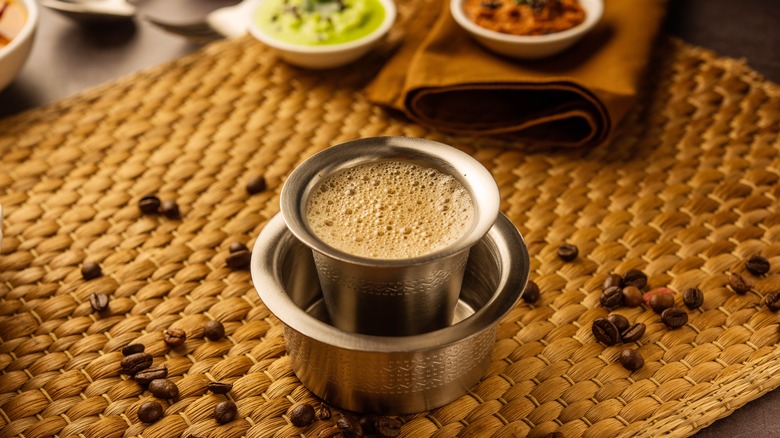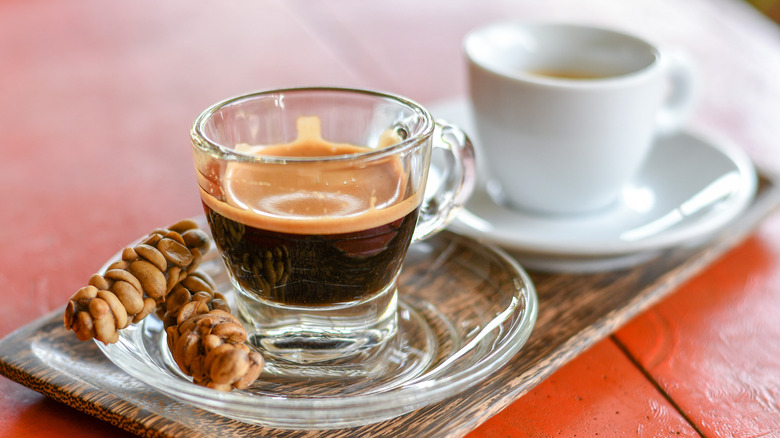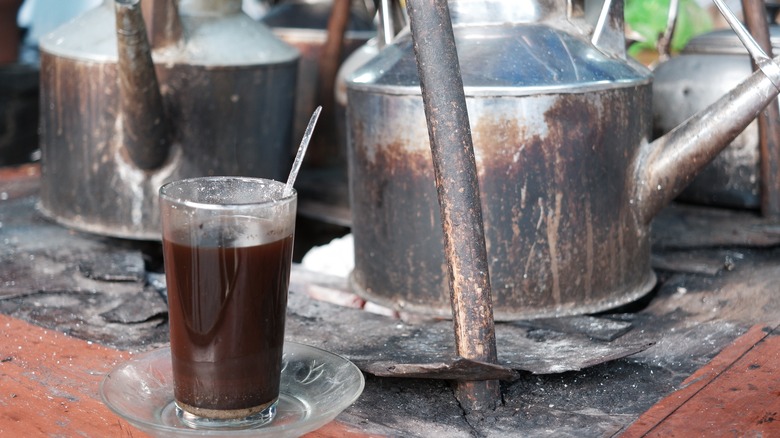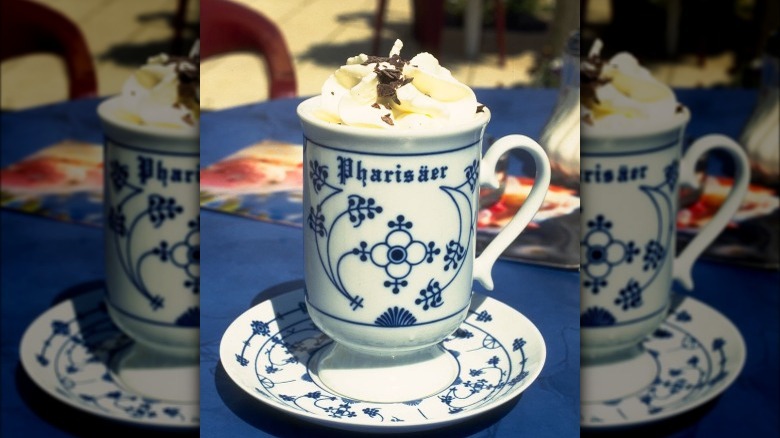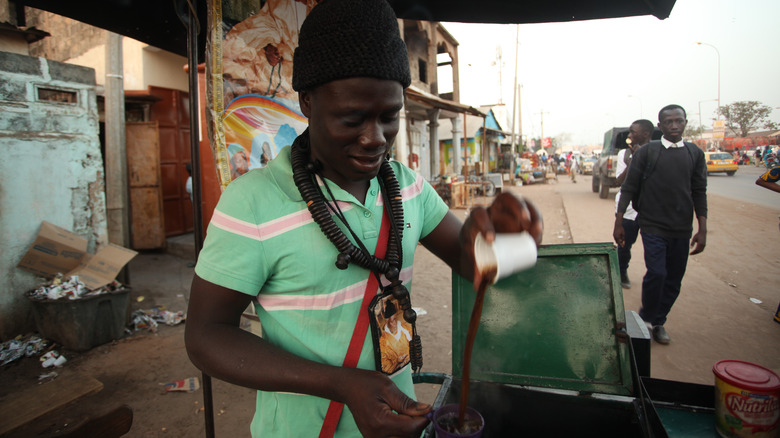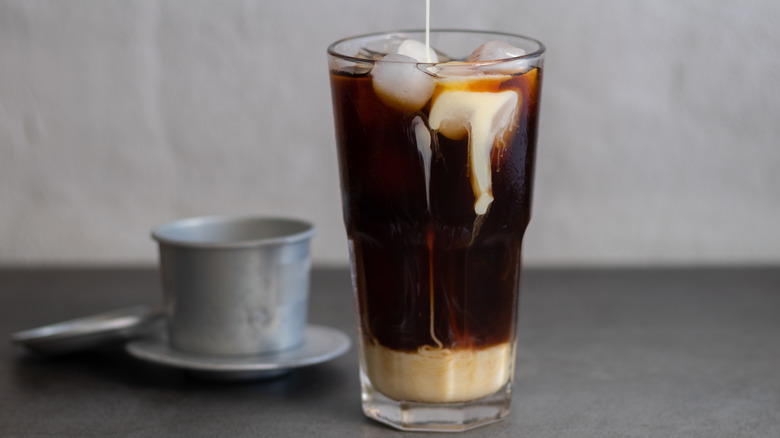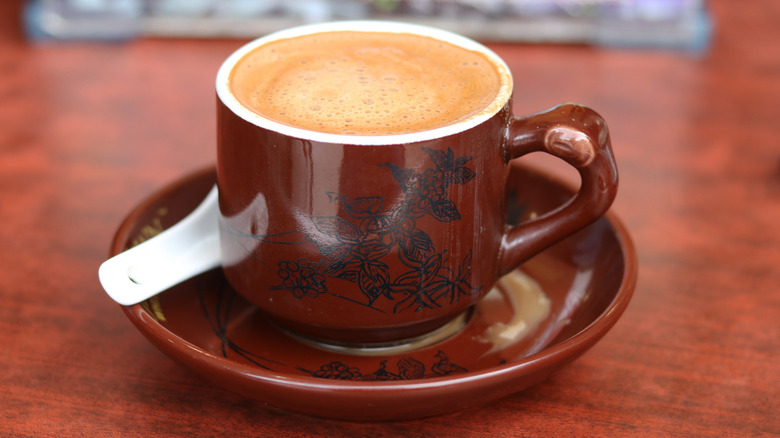14 Unique Coffee Drinks Around The World
The world is hooked on coffee. This bitter, caffeine-packed drink has come a long way from its humble beginnings and is now one of the most traded goods in the world (via Admiral Markets). Coffee does come in many shapes and sizes, but it all starts with the same plant whose effects were allegedly first discovered in Ethiopia. The coffee bean later traveled to the Arabian Peninsula, and by the 17th century it reached Europe and the American continent, starting the global coffee expansion (via National Coffee Association). Despite the differences in origin, preparation techniques, and brewing styles, coffee is almost universal to all nations, and it's hard to find a place deprived of this dark-brown brew.
To show off coffee's international character, we've collected some unique coffee-based drinks enjoyed worldwide. The round-up stays clear of some classics, such as espressos, lattes, and flat whites and instead investigates some creative combinations that grew in particular regions and that, for the most part, remained a local specialty. Most of the drinks are easily recreated at home, so the list might inspire you to test your barista skills or, in an ideal scenario, to go and discover these coffee specialties at the places where they originated.
Café bombon
Although Spain is often left out of the global coffee talk, the country has a strong coffee-oriented culture and a long tradition of socializing over a cup of coffee. Along with classic coffee drinks enjoyed throughout the country, Spain is also home to several unique coffee creations. One of those is café bombon, a delicious combination of coffee and condensed milk (via Nescafe).
Café bombon is not complicated to make. It is usually prepared with an espresso shot topped with sweetened condensed milk. Other brews can be used instead of espresso, but the base must be strong and concentrated enough to pair with the rich condensed milk. For the less sweet version, sweetened condensed milk is simply swapped with the unsweetened milk. Café bombon is traditionally served in a small glass mug so that you can see those contrasting dark and white layers. The standard ratio is to use equal parts espresso and condensed milk, which creates a sweet and creamy drink that can even take the place of a dessert (via Your Dream Coffee).
Although this sweet creation is mainly associated with Valencia, Voltage Coffee reveals that it was first created in Costa del Azahar. Regardless of its origin, café bombon is a must-try Spanish coffee.
Bicerin
Italy might be synonymous with espresso and cappuccino — the two most revered Italian-born coffee drinks — but the country's rich coffee culture is home to many regional and seasonal caffeinated specials. One of those is the legendary bicerin, a layered drink with origins in Turin, a city that also gave birth to the Italian aperitivo culture (via Walks of Italy). As explained by The Woke Lark, bicerin is an espresso drink combined with chocolate and lightly whipped cream that is traditionally served in a tall stemmed glass. Traditionally, each glass will consist of hot chocolate, followed by coffee, and then finished with a generous serving of whipped cream.
The drink originated at Caffè al Bicerin, a historic Turin coffee house still serving this delicious creation with house-made hot chocolate and a special coffee brew. As explained, the unique combination of carefully selected ingredients makes a great bicerin. The trick is to avoid mixing it; instead, you are encouraged to slowly sip through the layers. The drink is now available in other coffee bars across the city.
Café del tiempo
Despite a slightly confusing name — café del tiempo would roughly translate as weather or time coffee — this Spanish coffee is essentially iced coffee, and it couldn't be easier to prepare. The order of café del tiempo will include a cup of freshly brewed coffee and a glass of ice on the side. Occasionally, it will also incorporate a lemon slice. The right way to enjoy it is to add sugar to your coffee (if you like it sweet), and then pour the sweetened mix into the ice-filled glass. Any coffee can be served del tiempo style, including classic espresso, cortado (espresso with milk), and even some local specialty coffees (via Tours in Valencia).
Café del tiempo is mainly associated with Valencia, where the locals prefer to enjoy it during spring and summer. Outside the Valencian region, the moniker del tiempo is not as widely understood, so if you prefer your coffee served on the rocks, try asking for café con hielo (coffee with ice).
Dalgona
Dalgona was the biggest (or perhaps the only) winner of 2020, the year of the global pandemic that forced the entire world to refrain from some everyday rituals. As coffee shops closed, everyone was looking for a way to brew a delicious cup of coffee at home. That's when dalgona entered the spotlight. The combination of instant coffee, hot water, milk, and sugar whipped up into a creamy and frothy delight was first popularized on TikTok, and it quickly took the internet by storm (via Coffee Affection). It seemed everyone across all social media platforms was trying to whip up dalgona. Arguably, it was the trendiest drink that year.
Though most people got to know it as South Korean coffee, Coffee Affection explains that these whipped coffee styles have long existed in several Asian countries and are typically called whipped or beaten coffee. In South Korea, the drink was popularized by Jong Il-woo, an actor who tasted whipped coffee on a reality show and claimed that it resembled dalgona candy, a traditional South Korean street food snack made with sugar and baking soda that also has a distinctive caramel color. From then on, whipped coffee became internationally known as dalgona.
To make it, just briskly whisk equal parts instant coffee, hot water, and sugar. When the mix attains the desired texture and creaminess, serve it on top of warm or chilled milk.
Arabic coffee
Arabic coffee is not a drink designed solely to provide caffeine; it is a local ritual and a cultural heritage that have been preserved for centuries. Although the term sometimes refers to Turkish-style coffee, the Arabic version, also called gahwa, is a unique drink that originated on the Arabian Peninsula and is still a favorite pastime drink used as a symbol of generosity and welcome (via Forever Tourism).
In 2015, UNESCO listed Arabic coffee as an Intangible Cultural Heritage. As explained, this coffee is a symbol of hospitality and is usually prepared in full view of visitors. The process starts by roasting and grinding the beans. Ground coffee is then brewed and poured into a serving pot with a long spout that the hosts use to pour coffee for each guest. Tradition suggests that coffee should be served according to age, starting with the eldest in the group. Usually, the cups are filled halfway and will typically be refilled during the ceremony.
Coffee blends for Arabic coffee will often include spices, most often cardamom, and sometimes cloves, cumin, or cinnamon. The coffee is typically not sweetened and is usually served with dates or other sweets. It is sipped from small, decorative cups that have no handles (via Day Out Dubai).
Shakerato
Italians sip on espresso all year long, regardless of season, but when the weather gets warmer, they like to indulge in icy espresso-based drinks. As usual, Italians do everything better, and the same goes for iced coffee. Forget about pouring hot coffee over ice and getting a diluted, bland drink. To get the perfect ice-cold coffee, you need to shake the espresso with ice. In Italy, the drink is known as shakerato, and as explained by Barista Magazine, it involves shaking freshly brewed espresso with sugar and ice. The shaken coffee mix is then strained into a glass. The result is a smooth, richly flavored coffee with a layer of feather-light foam. Most importantly, it is perfectly chilled without being diluted or weak. Shakerato has unknown origins, but you can easily find it in Italian coffee bars, though it is rarely seen and prepared outside Italy.
This elegant coffee is usually served in a stemmed glass; either a martini or coupe will work. At Barista Magazine, the recipe calls for simple syrup instead of sugar, though the authors note that sugar is traditionally used to make shakerato in its native country.
Eiskaffe
Although it translates as ice coffee, German Eiskaffe is better described as ice coffee on steroids. This unique drink combines brewed coffee with a scoop of vanilla ice cream. The combination is served in a tall, narrow glass and usually comes topped with whipped cream. If coffee with ice cream isn't your ideal summer drink, you can always go for classic coffee with ice, but make sure to order Kaffee auf Eiswürfeln (via Awesome German Language).
If you want to diverge from the classic version, Perfect Brew gives some suggestions on how to tweak this German-style coffee. One of the ideas is to play with ice-cream flavorings or to add a splash of liquor — which would closely resemble some holiday tipples, but no one can say that coffee, ice cream, and booze can't work as a perfect chilled summer drink. If you choose to make your version, feel free to play with additions or flavors, but make sure to use hot coffee as you want it to be hot enough to melt the ice cream.
Indian filter coffee
India has always been known as a tea-drinking nation and one of the biggest tea producers, but the country is no stranger to coffee. According to Coffee Intelligence, it seems that younger generations will probably drink more coffee than their predecessors. Southern Indian states have a strong coffee tradition, and the drink of choice is a type of filter coffee, also known as filter kaapi. Food and Road describes it as a combination of filter coffee, sugar, and boiled milk, which sounds somewhat similar to any other coffee-based beverage, but the distinctive preparation technique and a special coffee blend make this Indian version unique. Indian coffee is traditionally brewed with a metal filter consisting of two parts; The upper section contains coffee and water, and the lower part holds the filtered brew. This regional drink is finished with jaggery (unrefined cane sugar) and boiled milk.
Apart from the unique coffee filter, the authors at Food and Road explain that Indian filter coffee has a very distinctive character due to the addition of chicory, which affects the taste of the coffee and makes it less bitter.
Kopi luwak
Kopi luwak is a very unusual coffee that hails from Java, Indonesia. It is often dubbed as the most expensive coffee in the world, due to the unique production process that includes a civet (luwak). This small animal consumes coffee cherries (beans), digests them, and then excretes them. The excreted coffee beans are collected, cleaned, and then roasted and ground into a blend used to make coffee. The process allegedly results in a concentrated brew with a unique profile reminiscent of caramel and chocolate with hints of earthiness and musk.
Although this coffee is trendy and quite expensive — a pound can reach astronomical prices of around $600 — there are some opposing views regarding sustainability and animal rights. As Coffee Affection explains, most civets used for kopi luwak are caged, living in poor conditions with questionable sanitation and an imbalanced diet, which can cause numerous health-related problems for the animal. In addition, because of the popularity and prices of kopi luwak, there are many counterfeited versions on the market, so if you are a coffee enthusiast who wants to see what's the deal behind the most expensive coffee in the world, we recommend buying from certified shops, and ideally, purchasing kopi luwak produced with wild foraged beans.
Kopi joss
Kopi joss is an Indonesian coffee that is brewed with the addition of burning charcoal. Atlas Obscura describes it as a strong, sweetened coffee that is finished with a piece of burning charcoal. The charcoal addition will allegedly tone down the astringency, making coffee more palatable for those who can't tolerate its acidity. This belief was never proven, but it didn't stop kopi joss from becoming a must-try drink in the Indonesian city of Yogoharta. As you may imagine, adding a piece of burning charcoal would make the coffee bubble and hiss, and supposedly it was this hissing noise that gave the drink its name.
According to the local lore, kopi joss was invented sometime in the 1960s by a local named Mr. Man. The coffee was initially popularized among the adventurous and those bold enough to try it, but once its alleged medicinal properties were touted, it became a sought-after local drink.
Pharisäer
Pharisäer is a boozy coffee drink from northern Germany that combines strong black coffee and rum. It is traditionally served with a thick layer of fresh whipped cream. The unusual name of this signature coffee allegedly originated during a baptism ceremony. All Tastes German explains that the drink was created in Nordstrand after a congregation gathered for a religious celebration. Alcohol was strictly forbidden, but one witty guest thought that adding a splash of rum to coffee and using whipped cream to disguise the odor could pass undetected, but the pastor wasn't fooled. Learning of their devious action, he called the alcohol-drinking guests Pharisees, a term closely associated with hypocrisy. Despite the initial controversy, this spiked drink is now a comforting local specialty.
The Perfect Brew recommends using espresso for the best version of Pharisäer. White rum is an excellent choice, but aged rum, whiskey, or brandy make great alternatives. Whipped cream can be sweetened or plain, but avoid the canned stuff. Whip up fresh cream, and dust it with cocoa or cinnamon for the perfect version of this traditional spiked coffee.
Cafe Touba
Café Touba is a traditional Senegalese coffee. It is usually made with a robusta blend of coffee that also includes ground selim, a pepper-like seed known as Senegalese pepper that is harvested from evergreen trees native to eastern and western parts of Africa. The roast is typically dark, while selim delivers some spiciness and a subtly bitter, balsamic-like profile to the drink. Touba is usually brewed using a cloth filter and is sometimes sweetened. It is enjoyed throughout the country and is available at traditional casual restaurants called tanganas. Nowadays, it is available in coffee pods or as a pre-packed blend (via Perfect Daily Grind).
Touba has a long tradition in Senegal. It first appeared at the end of the 19th century and was first introduced by Amadou Bamba Mbacke, a Senegalese religious leader who became a prominent national figure. Consequently, café Touba became a strong identity symbol for many Senegalese (via Lavazza).
Vietnamese iced coffee
Coffee is major in Vietnam. It is a favorite local pastime and is thoroughly implemented in local culture and traditions. Coffee-based drinks are enjoyed throughout the country, and they are available at all times of the day (via Nam Coffee).
Although the country has numerous unique coffee drinks, including the famous egg coffee, the preferred choice among most locals is cà phê sữa đá, also known as Vietnamese iced coffee. Most traditional coffee drinks in Vietnam are brewed using the so-called phin filter, a metal filter that holds the coffee and water and allows the brew to drip slowly inside the glass. This brewing method is ideal for iced coffee, as it creates rich and concentrated drinks that remain strong when combined with ice. Besides coffee and ice, condensed milk is essential to every Vietnamese iced coffee. It delivers creaminess and sweetness, and it is a perfect match with robusta blends traditionally used in Vietnamese coffee culture (via Nguyen Coffee Supply).
Ipoh white coffee
Ipoh white coffee has a slightly deceiving name, as it is not white but rather results in a typical, dark-brown brew. The reason for the strange moniker lies in the unique local roasting technique. Home Grounds explains that the coffee beans are double roasted, first using a regular roasting technique and then using a slightly unusual combination of margarine and sugar, sometimes with sesame and ghee. Roasted beans are dried and ground into a powder that is then used for brewing coffee.
Margarine-roasting is an old regional tradition that appeared when the locals wanted to adapt bitter Western-style brews and make them more palatable. When brewed, Ipoh white coffee is typically combined with condensed milk and can be enriched with ghee. The result is a rich, creamy, and sweet coffee that best pairs with local specials such as curry mee or nasi lemak, but it also goes well with cakes.
